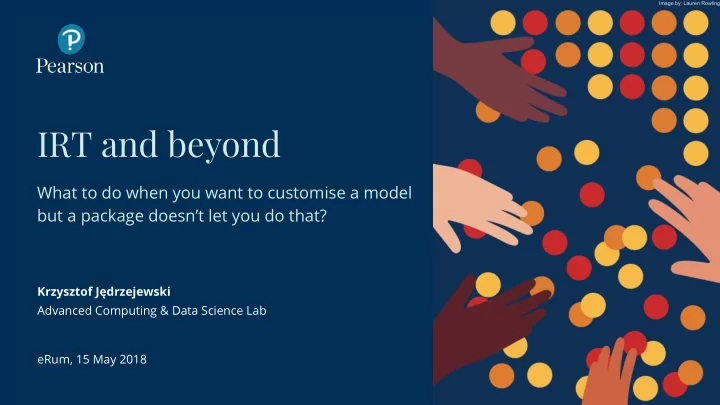

Image by: Lauren Rowling IRT and beyond What to do when you want to customise a model but a package doesn’t let you do that? Krzysztof Jędrzejewski Advanced Computing & Data Science Lab eRum, 15 May 2018 1 Presentation Title Arial Bold 7 pt
Code examples and slides github.com/kjedrzejewski/eRum2018 https://github.com/kjedrzejewski/eRum2018 2 eRum 2018
IRT Item Response Theory ● Used in psychometrics to estimate the difficulty of a test question (and a learner’s skill level) ● Can also be used in other areas, e.g. to assess ad clickability ● https://github.com/kjedrzejewski/eRum2018 3 eRum 2018
1PL IRT model 1-parameter logistic (1PL) is the most basic IRT model ● Assumption: the probability of answering a test question correctly depends only ● on the difference between a student’s skill and that question’s difficulty Observed data: ● which question was answered? ○ by which student? ○ was the answer correct or incorrect? ○ https://github.com/kjedrzejewski/eRum2018 4 eRum 2018
Many ways to estimate parameter values with R Using a dedicated IRT package, e.g. TAM ● As random effects in logistic regression model, e.g. with lme4 ● Using gradient descent, e.g. with TensorFlow ● Using probabilistic programming, e.g. with stan or greta ● TensorFlow stan greta https://github.com/kjedrzejewski/eRum2018 5 eRum 2018
Using a dedicated IRT package + We just need to convert the data to the expected format and call a function + Usually the fastest way to estimate model parameters - Such packages almost always support only most popular models - Doesn’t let us to estimate a custom model parameters Example packages: TAM , eRm , mirt Example code: github.com/kjedrzejewski/eRum2018/blob/master/1pl_irt.R http://www.edmeasurementsurveys.com/TAM/Tutorials/ 6 eRum 2018
Using logistic regression with random effects Question difficulties and skill levels are random effects related to questions and students + Allows us to add additional variables and parameters to the model - The model needs to remain a linear combination of observed variables Example packages: lme4 Example code: github.com/kjedrzejewski/eRum2018/blob/master/1pl_me.R https://github.com/lme4/lme4 7 eRum 2018
Using gradient descent (e.g. with TensorFlow ) Maximum Likelihood Estimation of model parameters using cross entropy and gradient descent based optimisers + Allows us to have non-linear components in the model + Can use GPU to speed up computations - We need to write a lot of code to describe dependencies between data and model parameters, and to establish the optimisation process - We need to create our own stop condition Example packages: tensorflow Example code: github.com/kjedrzejewski/eRum2018/blob/master/1pl_tf.R https://tensorflow.rstudio.com 8 eRum 2018
Using probabilistic programming (with stan ) + Provides credible intervals of estimated model parameters, which gives us information about the precision of our estimates - Model needs to be expressed in the stan language - Sampling is time-consuming , esp. for big datasets Example packages: rstan Example code: github.com/kjedrzejewski/eRum2018/blob/master/1pl_stan.R http://mc-stan.org/users/interfaces/rstan 9 eRum 2018
Using probabilistic programming (with greta ) + Also gives us information on the precision of our estimates (like stan ) + We define the model using native R syntax (unlike stan ) + It’s built on top of TensorFlow, so it can leverage GPU for computation - Sampling is still time-consuming Example packages: greta Example code: https://github.com/kjedrzejewski/eRum2018/blob/master/1pl_greta.R https://greta-dev.github.io/greta/ 10 eRum 2018
Benchmark, 1PL, small sample 100 questions, 1000 people => 100 000 observations Macbook Pro (CPU-only calculations) TAM 0.9 s lme4 24.3 s tensorflow 4.5 min. greta 18.9 min. stan 32.2 min. https://github.com/kjedrzejewski/eRum2018/blob/master/tests_1pl.R 11 eRum 2018
Benchmark, 1PL, small sample 100 questions, 1000 people => 100 000 observations Macbook Pro AWS p3.2xlarge GPU speed-up (CPU-only calculations) nVidia Tesla V100 TAM 0.9 s lme4 24.3 s tensorflow 4.5 min. 1.7 min. ~2.65x greta 18.9 min. 11.9 min. ~1.59x stan 32.2 min. https://github.com/kjedrzejewski/eRum2018/blob/master/tests_1pl.R 12 eRum 2018
Benchmark, 1PL, large sample 500 questions, 5000 people => 2 500 000 observations Macbook Pro AWS p3.2xlarge GPU speed-up (CPU-only calculations) nVidia Tesla V100 TAM 47.3 s lme4 30.2 min. tensorflow 42.4 min. 3.8 min. ~11.16x greta 5.8 h 39.4 min. ~8.83x stan too long :( https://github.com/kjedrzejewski/eRum2018/blob/master/tests_1pl.R 13 eRum 2018
Takeaways TensorFlow may be used for other tasks ● than deep learning GPU may be used to speed up ● parameter estimation of a large group of models For large samples, it may be faster to estimate ● parameters of a linear model using TensorFlow with GPU, than using specialized regression libraries Speed-up offered by GPU increases with data size ● https://github.com/kjedrzejewski/eRum2018 14 eRum 2018
ioki.pl/category/data-science/
Recommend
More recommend